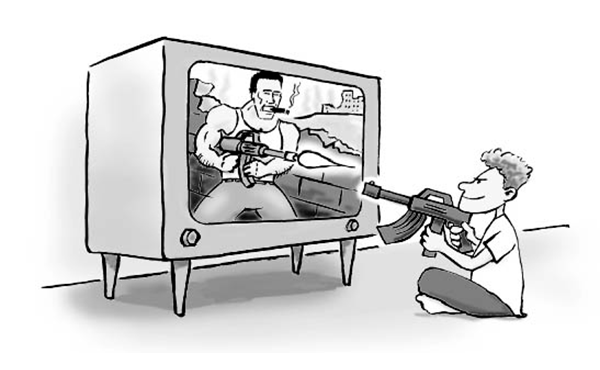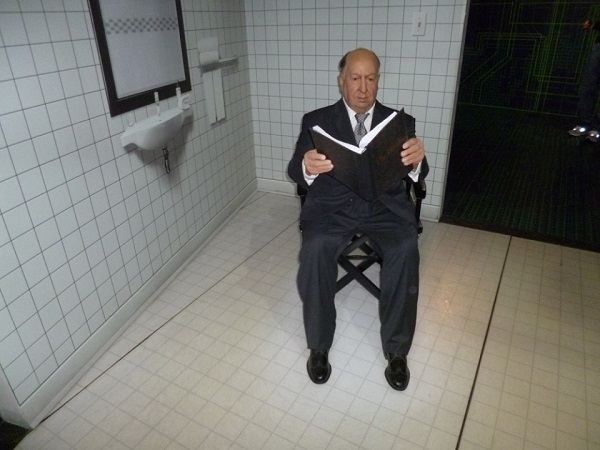
How Violent Media Affects Young People [Video]
Video uploaded by TMJ4 News on January 10, 2018
TV VIOLENCE: SAYING NO TO TV MAYHEM AND TALKING BACK TO YOUR TV SET
TV violence is making us more fearful, if not more violent
For anyone who doubts the importance of television to American life in our days, consider this: where the TV set is located in a person’s home is the single most important factor in determining what kind of furniture to buy and how to decorate one’s home. In fact, when we design our living rooms, we do so under the assumption that the sofa will face the TV. That’s how critical the TV is in buying decisions and Internet hasn’t changed anything in this strategy (note that in a number of countries the sofa is usually placed as part of a conversation area, so it faces other seating.)
In an old, pre-internet era movie Network (1976), an aging television newscaster done in by poor ratings rants during his farewell broadcast, “I’m mad as hell and I’m not going to take it anymore.” That defiant scene may have its 2010s counterpart in the viewing public’s current dismay over the amount of violence on television. Indeed, according to a 2017 poll by Time magazine, over half the American public is “very concerned” about the amount of violence depicted in TV shows, movies, and popular music. Nearly three-quarters of those polled said they believe the depiction of violence numbs people to its effects and that it tells people that violence is fun and acceptable.
That violence has become a nearly ubiquitous feature on our TV screens is beyond dispute. One recent study by the Center for Media and Public Affairs, a Washington, D.C.-based research group that monitored a day of programming on major broadcast and cable channels in its local market, found 2,605 acts of violence in a single 18-hour-period. Other studies have estimated that by the time the average kid finishes grade school, he or she will likely have witnessed 100,000 acts of TV violence!
Psychologists and criminologists can’t be certain that watching TV violence encourages violent behavior, but hundreds of studies show an association between television violence and aggressive behavior in the young. A few years ago, one often-cited study by University of Michigan found that the amount of TV violence watched by a group of young boys, was a better predictor of how aggressive they would be when they grew up than how their parents had otherwise raised them. The more TV violence the subjects had watched, the more aggressive and more likely to commit a crime they were a decade later.
Other studies have suggested that children who are exposed to violent media show a greater willingness to hurt others afterward, particularly if they were considered highly aggressive to begin with. Some psychologists and law-enforcement officials insist, however, that it is difficult to establish a cause-and-effect relationship between TV watching and violent behavior. There are too many other social factors, such as family breakdown and a lack of positive role models, to pin much blame on fictional TV violence, they argue.

Psychologists and criminologists can’t be certain that watching TV violence encourages violent behavior, but hundreds of studies show an association between television violence and aggressive behavior in the young
The bigger impact may come from local TV news, not entertainment programming, and may be more on those who are frightened bu what they see than on those who are moved to emulate it. Dr. Boris Sales, a leading expert on TV violence at the Annenberg School for Communication at the University of Pennsylvania, has found that heavy TV watchers are more likely to worry about the safety of their own neighborhood and to own guns for protection.
“The contribution of television to the committing of violence is relatively minor,” Sales said once in a New York Times interview. “Whereas the contribution of television to the perception of violence is much higher. People are almost paralyzed by fear.”
The revulsion against media violence is sparking a variety of protests against the companies that produce or air it. The attacks span the political spectrum from the White House to many medium- and low-ranking politicians. Groups as disparate as the Christian Film and Television Commission, the New York Urban League, the National Political Congress of Black Women are getting into the act…
There are indications that the backlash is beginning to have some effect. Both the TV networks and cable industries have asked independent organizations to help them monitor on-air violence better, and their reports show some decline in the amount of TV violence. Significantly, some advertisers are reported to be balking at sponsoring shows known for violence or other controversial material. Citizens’ groups are likely to influence more and exercise their pressure.
Consumers who are “mad as hell” should consider the advice of experts who say that if you see something that offends you, find out who the sponsor is, find out who’s on its board of directors… Send a letter to the members of the board. Ask them whether the staff realizes they are making huge profits from the brutal degradation of other human beings. Then send a copy of that letter to all of their neighbors and friend… You to try to introduce into the functioning of the market a moral sensibility that is usually absent.
If media and technology companies have their way, the attention to the TV will become even more dominant in the years ahead (and let’s say once again that Internet will change nothing, even when people can call up movies or shows of their choice, do their food shopping and banking at home, seek out and exchange information of personal and professional value at lighting speeds, play video games with opponents from all over the world thanks to Internet, but all that can’t displace the TV set from our living rooms).

TV violence and Alfred Hitchcock. Photo by iGotOffer.com.
One of the possible solutions to the problem of television violence may be an interactive TV that will let you roam the world without leaving home. Dozens of companies have made serious attempts at interactive TV. To supply the cornucopia of services, television networks, cable companies, publishers, movie studios are teaming up with everyone from Internet and cell phone carriers to computer software companies. They try to develop new products and services for this new information highway that will combine audio, video, text and other features in multimedia formats that will allow a viewer not only to see and hear what’s being piped into their home, but to ask questions, talk back, tailor the information content and viewing experience to fit their own personal tastes and needs.
Today, in the interactive era, consumers find themselves freed from the structures or scheduled television and cable programming because many of the new services are available on demand, 24 hours a day, by merely pushing a button or entering a code electronically on your home terminal (whether this terminal is a smart TV with computer intelligence or a computer that also behaves like a television set, is up to the viewer). The fact is that all programming in the new era is being delivered to the home in digital form and this fact has rendered obsolete our old definitions of what a television set and a computer are.
The problem is whether the old television violence can be stopped after we turn on our device and are greeted with a rotating three-dimensional carousel that displays a menu of interactive viewing choices. All this is great, but will the movie menu be stocked with thousands of titles offering violent content. Everything will depend on us, on our approach. The future of the TV world without violence rests not with the technology and the companies developing it, but with the consumers who must decide if they want their children live in a better world, the world without violence.
Links
- Roku – Streaming Player and Smart TV – Rpku
- Apple TV – Apple
- Tired of your Apple TV? Sell your old Apple TV online for top dollar!






Facebook
Twitter
RSS